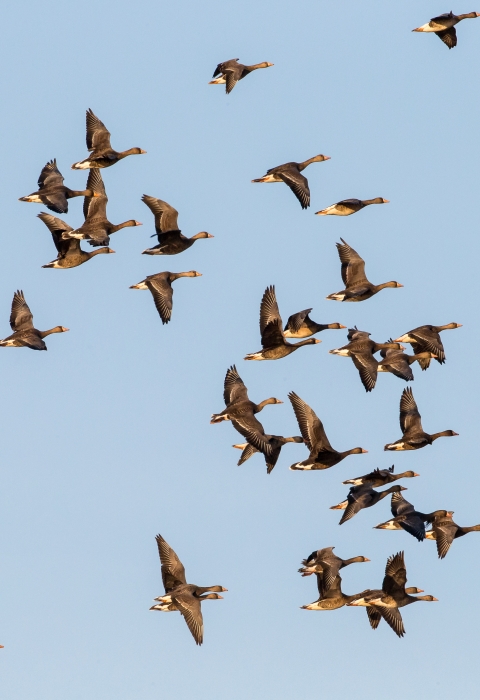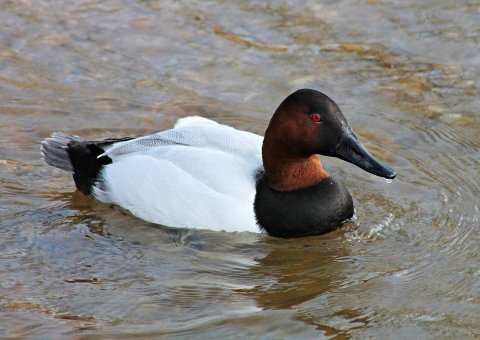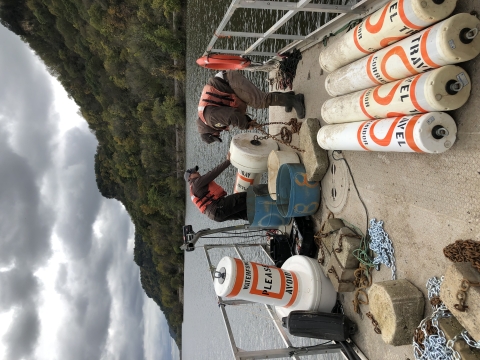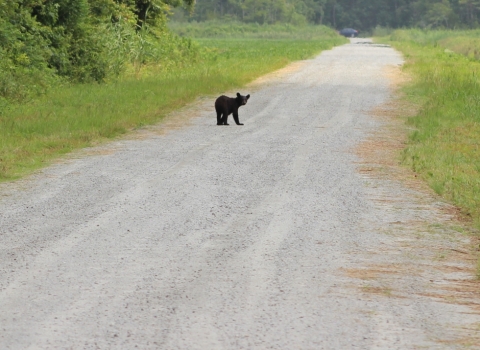Celebrating the fall migration
Mid-October through mid-November is an amazing time to see water birds on the Upper Mississippi River! As staff and volunteers share estimates of bird counts on the river, we'll update this page to share the news.
When do the birds arrive?
Dabbling ducks and American white pelicans arrive first in late summer and early fall. Diving ducks usually start getting here in mid-to-late October. Tundra swans typically show up in late October or early November. The weather greatly influences when the birds arrive, how long they will stay, and how concentrated they are on the river. Cold temperatures north of the refuge push birds to move south and arrive here on the river. If it's a warm fall, we'll likely see a slower migration. Many birds will stay until it gets cold enough for the Mississippi River to freeze over. When the Mississippi River freezes quickly, we see birds more concentrated in areas where there is still open water. When it freezes more slowly, we still see large numbers of birds, but they may be more spread out over open water. The peak of the tundra swan migration is typically the second or third week of November.
Why do they come here?
The Upper Mississippi River National Wildlife and Fish Refuge lies within the Mississippi Flyway, which is like a superhighway in the sky for birds! As one of the largest bodies of water in the Midwest, the Mississippi River takes longer to freeze than smaller rivers or ponds. It is also easy for birds to see from high above! The refuge offers high quality food sources for wildlife and shelter from the elements.
Recent bird sightings
There are many excellent places to see birds along the river! The following locations are some of the most popular walk-in or drive-in locations where refuge staff and volunteers are regularly able to visit to estimate bird numbers. Things are starting to freeze over but there are still a few places you can see birds. These sites are visible on the refuge Pool Maps. NOTE: These sites are not all updated on the same dates so some are more current then others.
Waterfowl are starting to arrive in numbers! Please feel free to share your sightings with us as well. You can email your sightings to us at uppermississippiriver@fws.gov
Pool 5 - Weaver Bottoms
The best place to see swans in the Weaver Bottoms area is from 116th Avenue/service road adjacent to MN Highway 61 near St. Mary's Cemetery. This location is about 17 miles north of Winona, MN.
Updated 11/16/23
600-700 swans; mostly all Tundra but I did hear a couple Trumpeters
100 Canada Geese
300 Dabbling ducks, mostly all Mallards, but I did see Northern Shoveler, Wood Duck, American Wigeon, Northern Pintail, Gadwall, and Green Wing Teal
5,000+ diving ducks far out and hard to see; Scaup, Ring-necked Duck, Canvasback
5 Bald Eagles
Pool 7 - Lake Onalaska Overlook
The Lake Onalaska Overlook is located at W7687 County Road ZB, Onalaska, WI, 54650. There's a small parking lot across the street from the overlook, or it's about a half mile walk from the La Crosse District Visitor Center. The Visitor Center has a large parking lot suitable for bus parking.
Updated Thurs. 11/9/23
Swans: There were about 1500-2000 swans in the distance on the Minnesota side of the river. There were also some American white pelicans there too.
Puddle ducks: 4000-6000 birds, mostly American coot, some gadwall, American wigeon, northern pintail and mallards
Other birds - red-tailed hawk
Pool 8 - Brownsville Overlook
The Brownsville Overlook is located about three miles south of Brownsville, MN off of MN Hwy 26. There are two spotting scopes available at this overlook. Binoculars are helpful, but birds can usually be viewed from the overlook deck even if you don't have a pair.
Updated 12/11/23
Canada geese - 20-30
Swans - 10-15
Bald eagles - 10-15 relatively close to the overlook and easily seen, 50-75 farther away and visible with binoculars or a scope
Nearly all the swans and other waterfowl that were at this location two weeks ago are gone. Many have likely left the refuge and are on the remaining leg of their fall migration, or maybe even settling in to their wintering ground. But many of them have simply shifted to a different part of Lower Pool 8 - the Crosby Slough area east of Brownsville, MN. The Crosby Slough area is in Wisconsin and the Wisconsin duck season is closed until next year. The Wisconsin goose season is closed this week but will reopen on December 16. The waterfowl have likely shifted to the Crosby Slough area, and other similar areas on the refuge, for two reasons (1) after concentrating in the refuge closed areas for the past two months, the amount of food in the closed areas is probably relatively low compared to areas outside the closed areas; and (2) hunting is not occurring in the areas outside of the closed areas, and boat traffic in general is also greatly reduced outside of the closed areas.
Pool 8 - Hwy 26 Overlook
The Hwy 26 Overlook is located about 3.5 miles south of Brownsville, MN off of MN Hwy 26. Binoculars are helpful but birds can often be seen from the deck without them.
Updated 12/11/23
There's a fair amount of ice but still plenty of open water.
Dabblers - 25-50 mallards
Divers - 100-150 common goldeneye, bufflehead, ring-necked duck
Canada geese - 100-200
Swans - 15-25 relatively close to the overlook, 200-400 farther away in scattered groups. Many of these were trumpeter swans but tundra swans were present as well.
Bald eagles - 10-15 relatively close to the overlook and easily seen, 50-75 farther away and visible with binoculars or a scope
Nearly all the swans and other waterfowl that were at this location two weeks ago are gone. Many have likely left the refuge and are on the remaining leg of their fall migration, or maybe even settling in to their wintering ground. But many of them have simply shifted to a different part of Lower Pool 8 - the Crosby Slough area east of Brownsville, MN. The Crosby Slough area is in Wisconsin and the Wisconsin duck season is closed until next year. The Wisconsin goose season is closed this week but will reopen on December 16. The waterfowl have likely shifted to the Crosby Slough area, and other similar areas on the refuge, for two reasons (1) after concentrating in the refuge closed areas for the past two months, the amount of food in the closed areas is probably relatively low compared to areas outside the closed areas; and (2) hunting is not occurring in the areas outside of the closed areas, and boat traffic in general is also greatly reduced outside of the closed areas.
Pool 8 - Shady Maple Overlook
Updated 11/16/23
The Shady Maple Overlook is located a few miles south of La Crosse on Hwy 35, just south of Goose Island Park.
Puddle ducks - 5,000-8,000 gadwall, northern pintail, American wigeon, mallard, wood duck, green-winged teal, American black duck
Canada geese - 30-50
Swans 300-500 (both tundra swans and trumpeter swans)
American white pelicans - 15-20
Pool 8 - Reno Bottoms Canoe Access
The Reno Bottoms Canoe Access is located off HWY 26, just east of Reno, Minnesota. This canoe access is managed by the Minnesota Department of Natural Resources and has a small gravel parking lot. Please be cautious crossing the railroad tracks. Visitors can walk out on a narrow dike/spillway that stretches several miles across the river. Please note that in high water conditions, water flows over the spillway and it's not safe to cross. We count birds close to first hundred yards of the spillway that visitors will be able to see with binoculars, but huge rafts of diving ducks are visible if you take a walk further down the spillway.
Update: 12/11/23
There's a lot of ice and almost no waterfowl, but there are still a lot of bald eagles that can be seen here.
Pool 8 Crosby Slough Area
Updated 12/11/23
This is an area of multiple channels and shallow backwater areas that is on the east side of the main channel, directly east of Brownsville, MN, and Wildcat Park and Boat Landing. Lots of the waterfowl that were previously in the Wisconsin Islands Closed Area (i.e., the areas visible from the Brownsville Overlook and the Hwy 26 Overlook) are now in the Crosby Slough area. The waterfowl have likely shifted to the Crosby Slough area, and other similar areas on the refuge, for two reasons (1) after concentrating in the refuge closed areas for the past two months, the amount of food in the closed areas is probably relatively low compared to areas outside the closed areas; and (2) hunting is not occurring in the Crosby Slough area and boat traffic in general is also greatly reduced outside of the closed areas. The Crosby Slough area is in Wisconsin and the Wisconsin duck season is closed until next year. The Wisconsin goose season is closed this week but will reopen on December 16.
Waterfowl in the Crosby Slough area are viewable with binoculars but a scope is even better. There are several large, gravel pull offs on the side of Hwy 26 in the Brownsville vicinity where cars can safely park and observers can get out and set up scopes. There are also some lightly traveled streets in Brownsville that offer an elevated view, and parking on the side of the street is safe.
Dabblers - 3000-5000 mallard, northern pintail, gadwall
Divers - 1000-2000 ring-necked duck, common goldeneye, bufflehead
Canada geese - 500-1000
Swans - 5000-10000
Bald eagles - 75-100
Lower Pool 9 - Various Locations
Updated 11/14/23
There are several safe viewing locations where Hwy 35 runs along the Wisconsin side of Lower Pool 9. One is called the Leitner Creek Overlook on Google Maps and it is directly across from Leitner Hollow Road, a little less than ½ mile north of the entrance road to the lock and dam. Another location, a little more than ½ mile upstream from the Leitner Creek Overlook, is a highway wayside area with a historical marker about log and lumber rafting on the Mississippi River during the 1800s and early 1900s. Finally, Depot Road is a short, elevated road above the Lynxville boat launch. It has ample pull-off space and is mostly travelled by vehicles pulling boat trailers and sometimes railroad crews. All of these areas provide opportunities to safely park and get out of your vehicle to view the massive flocks of diving ducks using Lower Pool 9 during migration. Sometimes binoculars are sufficient to scan the tens of thousands of ducks in the open impounded area of the pool, other times a spotting scope is the best equipment to use. Here's what was visible on November 14th:
Diving ducks - 25000-35000 canvasback, lesser scaup, common goldeneye, bufflehead and redhead could be seen stretching from near the dam all the way upstream to the Lynxville area. At the Leitner Creek overlook and the Hwy 35 wayside area, a spotting scope was the best way to see them, but binoculars worked as well. At the Lynxville boat launch binoculars were sufficient because there were many birds close to the boat launch.
Dabbling ducks - a few mallards were seen scattered around here and there at all three viewing locations.
Swans - from the Lynxville boat launch, 200-300 swans could be seen with a spotting scope around some of the constructed islands to the west of the boat launch.
Pool 9 - Red Oak Road
Birds can be seen from Red Oak Road, approximately 2.5 miles north of Harpers Ferry, Iowa in Allamakee County. To get there, follow X-52/Great River Road north from Harpers Ferry. Turn right, as X-52 curves left, onto Red Oak Road. Follow the narrow Red Oak Road upriver about 1.5 miles, and look for a cove where the swans gather.
Updated 11/27/23
500-1000 swans
100 bald eagles - there were 2 on almost every muskrat hut
Pool 13 - Spring Lake public use site
Updated 11/12/23
This public use site can be accessed by starting at the intersection of Hwy 52 and Hwy 84 in Savanna, IL, then travelling south on Hwy 84 for about 3 miles. Note that this site is about 1 mile south of the Frog Pond public use site. Both the Spring Lake site and Frog Pond site are on the west side of Hwy 84. If travelling north on Hwy 84, it is about 5 miles north of Thomson, IL, and about 1 mile north of Airport Road.
Right at the Spring Lake parking lot there is a set of permanently mounted spotting scopes looking over Lower Spring Lake, as well as a dike separating Lower Spring Lake to the south and Upper Spring Lake to the North. Both areas have a lot of emergent aquatic vegetation that obscures the views of a lot of waterbirds that are using these areas. In spite of that, a lot of waterbirds are visible in areas of open water. Also, there is an elevated wildlife observation deck located a little less than ½ mile north of the Spring Lake parking lot. It can be accessed by walking north on the public use trail located on top of a dike serving as the eastern boundary of Upper Spring Lake.
Dabblers - 4000-6000 gadwall, northern shoveler, northern pintail, mallard, green-winged teal, wood duck
Divers - 25-50 bufflehead
Canada geese - 1000-2000
Swans - 2000-4000 (only tundra swans were heard but there were likely trumpeter swans as well)
American white pelicans - 100-2000
Great blue herons - 3
Bald eagles - 20-30 (many of the eagles were actively hunting, flushing ducks into the air)
Pool 13 - Ingersoll Wetlands Learning Center wildlife observation site
Updated 11/12/23
This site is right across the road from the refuge's Savanna District office, which also house the refuge's Ingersoll Wetlands Learning Center at 6870 Riverview Rd, Thomson, IL 61285.
Dabblers - 100-200 close to the observation site, 1000-3000 were farther out. A mixture of northern shoveller, gadwall, mallard, and green-winged teal
Canada geese - 150-250
American coot - 2000-4000
Sandhill cranes - they use this area every day and refuge staff said there have been approximately 100 in recent days. None were observed on this visit so they were likely feeding in the nearby crop fields.
Bald eagles - 10-15
Lower Pool 13 - Potters Marsh
Updated 11/11/23
Potters Marsh and Lower Pool 13 are good viewing sites accessed by driving south on Hwy 84 from Thomsen, IL, then turning right (west) on Lock Road. Lock Road runs along the south side of Potters Marsh and terminates at a boat landing and elevated parking lot overlooking lower Pool 13.
Potters Marsh
Dabbling ducks - 500-1000 mallards, gadwall
Diving ducks - 50-100 lesser scaup
Other water birds: 2000-4000 American coots, a pied-billed grebe and 5-10 American bald eagles
Lower Pool 13
Dabbling ducks - 500-1000 mallards, gadwall, American wigeon feeding with the diving ducks out in the open water
Diving ducks - 20000-30000 lesser scaup, canvasback, bufflehead, ruddy duck, common merganser
Double-crested cormorant - 50-150
Bald eagle - 15-20
A lot of the ducks were easily viewed with binoculars from the parking lot on the upstream side of the lock, but a good spotting scope allows you to see the tens of thousands of ducks that extend a loooong way up the pool.
Voluntary Waterfowl Avoidance Areas
There are few places quite like the refuge to experience the fall migration! Boaters enjoying the river can help keep this a great place for people and wildlife by watching out for special Voluntary Waterfowl Avoidance Areas during the peak of the migration. From October 15 through mid-November, all boaters are asked to avoid these "refuges within the refuge" to give waterfowl a place to rest without being startled off the water. Voluntary Waterfowl Avoidance Areas are marked with either orange-and-white buoys on the water or orange-and-blue Special Regulation Signs posted along area boundaries. These locations are also shown on the refuge Pool Maps. Making this change for about a month of our lives can make a big difference for theirs! Thanks for being part of our conservation community and for playing a role in their survival!





